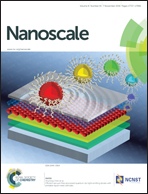Efficiency improvement using bis(trifluoromethane) sulfonamide lithium salt as a chemical additive in porphyrin based organic solar cells†
Abstract
Two new conjugated acceptor–π-donor–π-acceptor (A–π-D–π-A) porphyrins have been synthesised using 3-ethylrhodanine (1a) or dicyanovinylene (1b) groups as acceptor units. Their optical and electrochemical properties made these materials excellent electron donors along with PC71BM as the acceptor for solution-processed bulk heterojunction organic solar cells. The devices based on 1a:PC71BM (1 : 2) and 1b:PC71BM (1 : 2) processed with CB showed low power conversion efficiencies (PCE) of 2.30% and 2.80%, respectively. Nonetheless, after processing the active layer using a mixture of 3 vol% of a pyridine additive in THF, the PCE was enhanced up to 5.14% and 6.06% for 1a:PC71BM and 1b:PC71BM, respectively. Moreover, when we used LiTFSI as the chemical additive in pyridine/CB-processed 1b:PC71BM an excellent PCE of 7.63% was recorded. The effects over the film morphology and the device characteristics (Jsc, Voc and FF) due to the introduction of LiTFSI are discussed.


 Please wait while we load your content...
Please wait while we load your content...